Diblock Copolymers Containing Titanium-Hybridized Polyhedral Oligomeric Silsesquioxane Used as a Macromolecular Flame Retardant for Epoxy Resin
Abstract
:1. Introduction
2. Materials and Methods
2.1. Materials
2.2. Synthesis of DOPO-Containing Copolymers and Ti-POSS Grafted Copolymers
2.3. Preparation of EP/Polyti Composites
2.4. The Migration of DOPO Moiety from EP Composites
2.5. Characterization
3. Results and Discussions
3.1. Chemical Structural Characterizations
3.1.1. DOPO-Containing Copolymers poly(HAMAm-b-HEPOMAn)
3.1.2. Grafted Copolymers PolyTi and PolyC
3.2. Thermal Stability of Grafted Copolymers PolyTi and PolyC
3.2.1. Thermal Properties of Grafted Copolymers
3.2.2. Thermal Stability of Grafted Copolymers
3.2.3. XRD Analysis
3.3. The Compatibility of PolyTi and PolyC in Epoxy Resin
3.4. Flame Retardancy of EP Composites
3.5. Thermal Properties of EP Composites
3.6. Mechanical and Thermomechanical Properties of EP Composites
3.7. The Migration of DOPO from EP Composites
3.8. Comparison of Properties of Obtained Material with Materials Described in the Literature
4. Conclusions
Author Contributions
Funding
Institutional Review Board Statement
Informed Consent Statement
Data Availability Statement
Conflicts of Interest
References
- Liu, Q.Y.; Wang, D.H.; Li, Z.K.; Li, Z.F.; Peng, X.L.; Liu, C.B.; Zhang, Y.; Zhang, P.L. Recent developments in the flame-retardant system of epoxy resin. Materials 2020, 13, 2045. [Google Scholar] [CrossRef] [PubMed]
- Kandola, B.K.; Magnoni, F.; Ebdon, J.R. Flame retardants for epoxy resins: Application-related challenges and solutions. J. Vinyl Addit. Technol. 2022, 28, 17–49. [Google Scholar] [CrossRef]
- Chen, L.; Wang, Y.Z. A review on flame retardant technology in China. Part 1: Development of flame retardants. Polym. Adv. Technol. 2010, 21, 1–26. [Google Scholar] [CrossRef]
- Huo, S.Q.; Song, P.A.; Yu, B.; Ran, S.Y.; Chevali, V.S.; Liu, L.; Fang, Z.P.; Wang, H. Phosphorus-containing flame retardant epoxy thermosets: Recent advances and future perspectives. Prog. Polym. Sci. 2021, 114, 101366. [Google Scholar] [CrossRef]
- Chrusciel, J.J.; Lesniak, E. Modification of epoxy resins with functional silanes, polysiloxanes, silsesquioxanes, silica and silicates. Prog. Polym. Sci. 2015, 41, 67–121. [Google Scholar] [CrossRef]
- Chen, S.S.; Ai, L.H.; Zhang, T.; Liu, P.; Liu, W.S.; Pan, Y.H.; Liu, D.F. Synthesis and application of a triazine derivative containing boron as flame retardant in epoxy resins. Arab. J. Chem. 2020, 13, 2982–2994. [Google Scholar] [CrossRef]
- Zhang, X.H.; Min, Y.Q.; Hua, Z.J. Epoxy-based electronic materials containing nitrogen heterocyclic ring: Flame retardancy. Prog. Chem. 2014, 26, 1021–1031. [Google Scholar]
- Battig, A.; Markwart, J.C.; Wurm, F.R.; Schartela, B. Sulfur’s role in the flame retardancy of thio-ether-linked hyperbranched polyphosphoesters in epoxy resins. Eur. Polym. J. 2020, 122, 109390. [Google Scholar] [CrossRef]
- Pan, Y.T.; Zhang, Z.D.; Yang, R.J. The rise of MOFs and their derivatives for flame retardant polymeric materials: A critical review. Compos. Pt. B Eng. 2020, 199, 108265. [Google Scholar] [CrossRef]
- Wang, X.; Hu, Y.; Song, L.; Yuan, H.Y.; Xing, W.Y.; Lu, H.D. Synthesis and characterization of a DOPO-substitued organophosphorus oligomer and its application in flame retardant epoxy resins. Prog. Org. Coat. 2011, 71, 72–82. [Google Scholar] [CrossRef]
- Qin, J.Y.; Zhang, W.C.; Yang, R.J. Intercalation process in the preparation of 9,10-dihydro-9-oxa-10-phosphaphenanthrene-10-oxide-montmorillonite nanocompounds and their application in epoxy resins. Mater. Des. 2019, 178, 107834. [Google Scholar] [CrossRef]
- Wu, K.; Song, L.; Hu, Y.; Lu, H.D.; Kandola, B.K.; Kandare, E. Synthesis and characterization of a functional polyhedral oligomeric silsesquioxane and its flame retardancy in epoxy resin. Prog. Org. Coat. 2009, 65, 490–497. [Google Scholar] [CrossRef]
- Nguyen, V.H.; Vu, C.M.; Thi, H.V. MWCNT grafted with POSS-based novel flame retardant-filled epoxy resin nanocomposite: Fabrication, mechanical properties, and flammability. Compos. Interfaces 2021, 28, 843–858. [Google Scholar] [CrossRef]
- Zhai, C.C.; Xin, F.; Cai, L.Y.; Chen, Y.; Qian, L.J. Flame retardancy and pyrolysis behavior of an epoxy resin composite flame-retarded by diphenylphosphinyl-POSS. Polym. Eng. Sci. 2020, 60, 3024–3035. [Google Scholar] [CrossRef]
- Wu, F.Y.; Bao, X.H.; Wang, J.B. One-step reduction of graphene oxide with phosphorus/silicon-containing compound and its flame retardancy in epoxy resin. Polymers 2021, 13, 3985. [Google Scholar] [CrossRef]
- Fang, F.; Ran, S.Y.; Fang, Z.P.; Song, P.G.; Wang, H. Improved flame resistance and thermo-mechanical properties of epoxy resin nanocomposites from functionalized graphene oxide via self-assembly in water. Compos. Pt. B Eng. 2019, 165, 406–416. [Google Scholar] [CrossRef]
- Rao, W.H.; Zhao, P.; Yu, C.B.; Zhao, H.B.; Wang, Y.Z. High strength, low flammability, and smoke suppression for epoxy thermoset enabled by a low-loading phosphorus-nitrogen-silicon compound. Compos. Pt. B Eng. 2021, 211, 108640. [Google Scholar] [CrossRef]
- Liu, C.; Chen, T.; Yuan, C.H.; Song, C.F.; Chang, Y.; Chen, G.R.; Xu, Y.T.; Dai, L.Z. Modification of epoxy resin through the self-assembly of a surfactant-like multi-element flame retardant. J. Mater. Chem. A 2016, 4, 3462–3470. [Google Scholar] [CrossRef]
- Wang, X.; Xing, W.Y.; Feng, X.M.; Yu, B.; Lu, H.D.; Song, L.; Hu, Y. The effect of metal oxide decorated graphene hybrids on the improved thermal stability and the reduced smoke toxicity in epoxy resins. Chem. Eng. J. 2014, 250, 214–221. [Google Scholar] [CrossRef]
- Zhang, Z.D.; Qin, J.Y.; Zhang, W.C.; Yang, R. Synthesis of a novel dual layered double hydroxide hybrid nanomaterial and its application in epoxy nanocomposites. Chem. Eng. J. 2020, 381, 122777. [Google Scholar] [CrossRef]
- Peng, C.H.; Chen, T.; Zeng, B.R.; Chen, G.R.; Yuan, C.H.; Xu, Y.T.; Dai, L.Z. Anderson-type polyoxometalate-based hybrid with high flame retardant efficiency for the preparation of multifunctional epoxy resin nanocomposites. Compos. Pt. B Eng. 2020, 186, 107780. [Google Scholar] [CrossRef]
- Wu, H.Y.; Zeng, B.R.; Chen, J.M.; Wu, T.; Li, Y.T.; Liu, Y.Z.; Dai, L.Z. An intramolecular hybrid of metal polyhedral oligomeric silsesquioxanes with special titanium-embedded cage structure and flame retardant functionality. Chem. Eng. J. 2019, 374, 1304–1316. [Google Scholar] [CrossRef]
- Zeng, B.R.; Hu, R.; Zhou, R.R.; Shen, H.; Liu, X.Y.; Chen, G.R.; Xu, Y.T.; Yuan, C.H.; Luo, W.A.; Dai, L.Z. Co-flame retarding effect of ethanolamine modified titanium-containing polyhedral oligomeric silsesquioxanes in epoxy resin. Appl. Organomet. Chem. 2020, 34, 5266. [Google Scholar] [CrossRef]
- Han, X.; Zhang, X.H.; Guo, Y.; Liu, X.Y.; Zhao, X.J.; Zhou, H.; Zhang, S.L.; Zhao, T. Synergistic effects of ladder and cage structured phosphorus-containing POSS with tetrabutyl titanate on flame retardancy of vinyl epoxy resins. Polymers 2021, 13, 1363. [Google Scholar] [CrossRef]
- Zeng, B.R.; He, K.B.; Wu, H.Y.; Ye, J.Y.; Zheng, X.H.; Luo, W.A.; Xu, Y.T.; Yuan, C.H.; Dai, L.Z. Zirconium-embedded polyhedral oligomeric silsesquioxane containing phosphaphenanthrene-substituent group used as flame retardants for epoxy resin composites. Macromol. Mater. Eng. 2021, 306, 2100012. [Google Scholar] [CrossRef]
- Zeng, T.; Yang, D.G.; Li, H.M.; Chen, C.; Gao, H. The fabrication of amphiphilic double dynamers for responsive pickering emulsifiers. Polym. Chem. 2018, 9, 627–636. [Google Scholar] [CrossRef]
- Ye, H.L.; Wu, Y.G.; Chen, G.R.; Liu, C.; Luo, W.A.; Yuan, C.Y.; Xu, Y.T.; Dai, L.Z. Flame retardant hybrid nanoparticles modified epoxy. Polym. Mater. Sci. Eng. 2016, 32, 20–25. [Google Scholar]
- Zhang, J.T.; Wu, W.Q.; Lv, Y.; Gao, G.L.; Xu, Y.T.; Zeng, B.R.; Dai, L.Z. Grafting multi-elements hybrid polymer brushes on graphene oxide for epoxy composite with excellent flame retardancy. J. Appl. Polym. Sci. 2021, 138, 50923. [Google Scholar] [CrossRef]
- Selvaraj, M.; Maruthan, K.; Palraj, S.; Venkatachari, G. Preparation and characterization of thermally stable epoxy-titanate coatings. Prog. Org. Coat. 2010, 67, 339–347. [Google Scholar] [CrossRef]
- Wang, X.; Hu, Y.; Song, L.; Xing, W.Y.; Lu, H.D.; Lv, P.; Jie, G.X. Flame retardancy and thermal degradation mechanism of epoxy resin composites based on a dopo substituted organophosphorus oligomer. Polymer 2010, 51, 2435–2445. [Google Scholar] [CrossRef]
- Liu, B.; Liu, J.P.; Gao, X.Y.; Tai, F.; Xia, Z.D.; Guo, F. Effect of ther momechanical fatigue on properties of lead -free solder joint with nano-structured reinforcements. Rare Met. 2009, 33, 205–210. [Google Scholar]
- Yang, X.B.; Huang, L.Q.; Li, J.T.; Tang, X.Y.; Luo, X.T. Fabrication of SiO2@silicalite and its use as a catalyst support. RSC Adv. 2017, 7, 12224–12230. [Google Scholar] [CrossRef] [Green Version]
- Zeng, B.R.; Yang, L.; Chen, J.M.; Liu, X.Y.; Wu, H.Y.; Zheng, W.; Chen, G.R.; Xu, Y.T.; Dai, L.Z. Improving the flame retardancy and thermal property of organotitanate-modified epoxy resin for electronic application via a simple method. High Perform. Polym. 2019, 31, 12–23. [Google Scholar] [CrossRef]
- Yang, X.B.; Gan, C.H.; Xiong, H.P.; Luo, X.T. Fabrication and characterization of SiO2@TiO2@silicalite catalyst and its application for degradation of rhodamine B. RSC Adv. 2016, 6, 105737–105743. [Google Scholar] [CrossRef]
- Liao, S.H.; Liu, P.L.; Hsiao, M.C.; Teng, C.C.; Wang, C.A.; Ger, M.D.; Chiang, C.L. One-step reduction and functionalization of graphene oxide with phosphorus-based compound to produce flame-retardant epoxy nanocomposite. Ind. Eng. Chem. Res. 2012, 51, 4573–4581. [Google Scholar] [CrossRef]
- Zeng, B.R.; Liu, Y.Z.; Yang, L.; Zheng, W.; Chen, T.; Chen, G.R.; Xu, Y.T.; Yuan, C.H.; Dai, L.Z. Flame retardant epoxy resin based on organic titanate and polyhedral oligomeric silsesquioxane containing additives with synergistic effects. RSC Adv. 2017, 7, 26082–26088. [Google Scholar] [CrossRef] [Green Version]
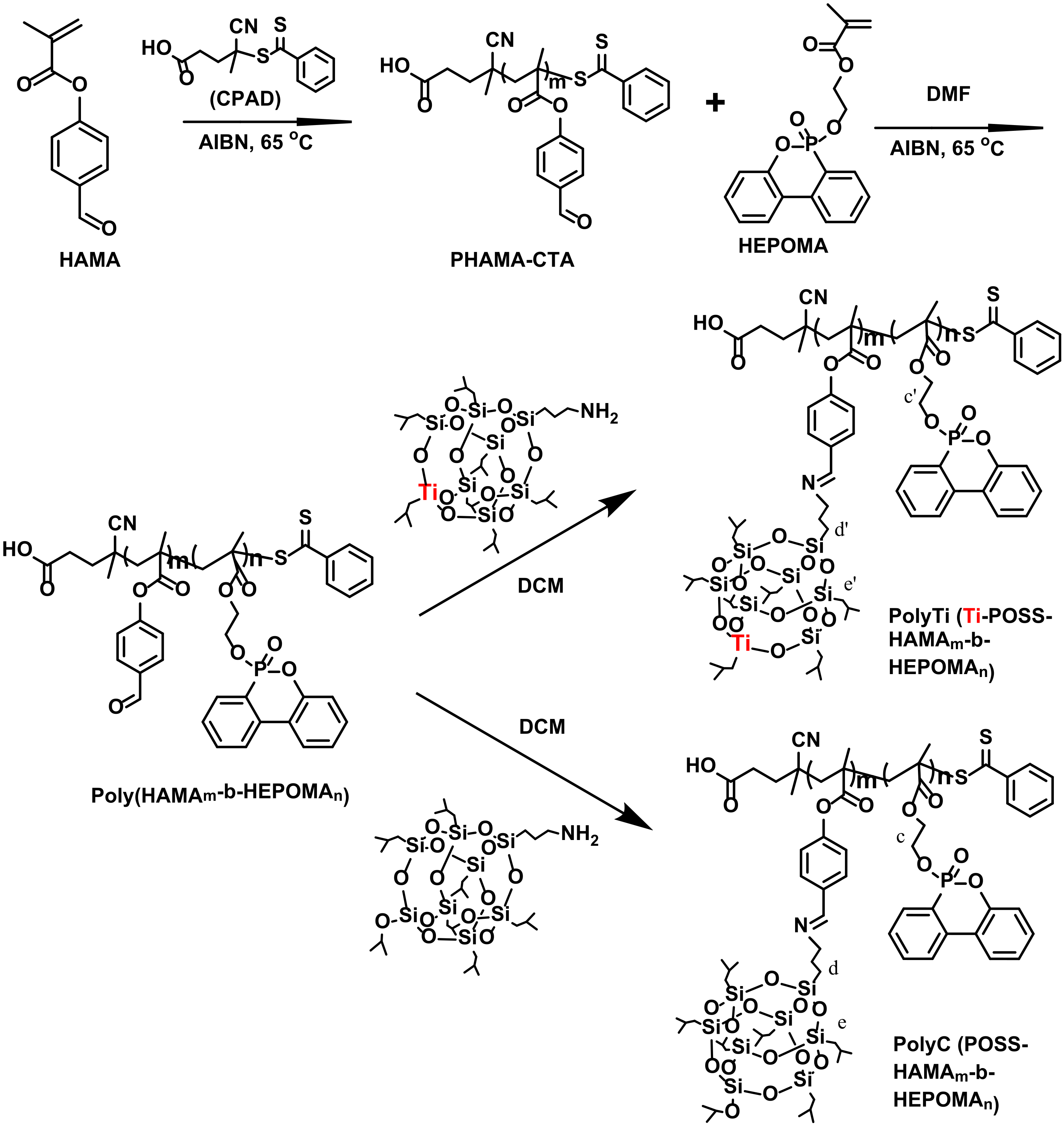



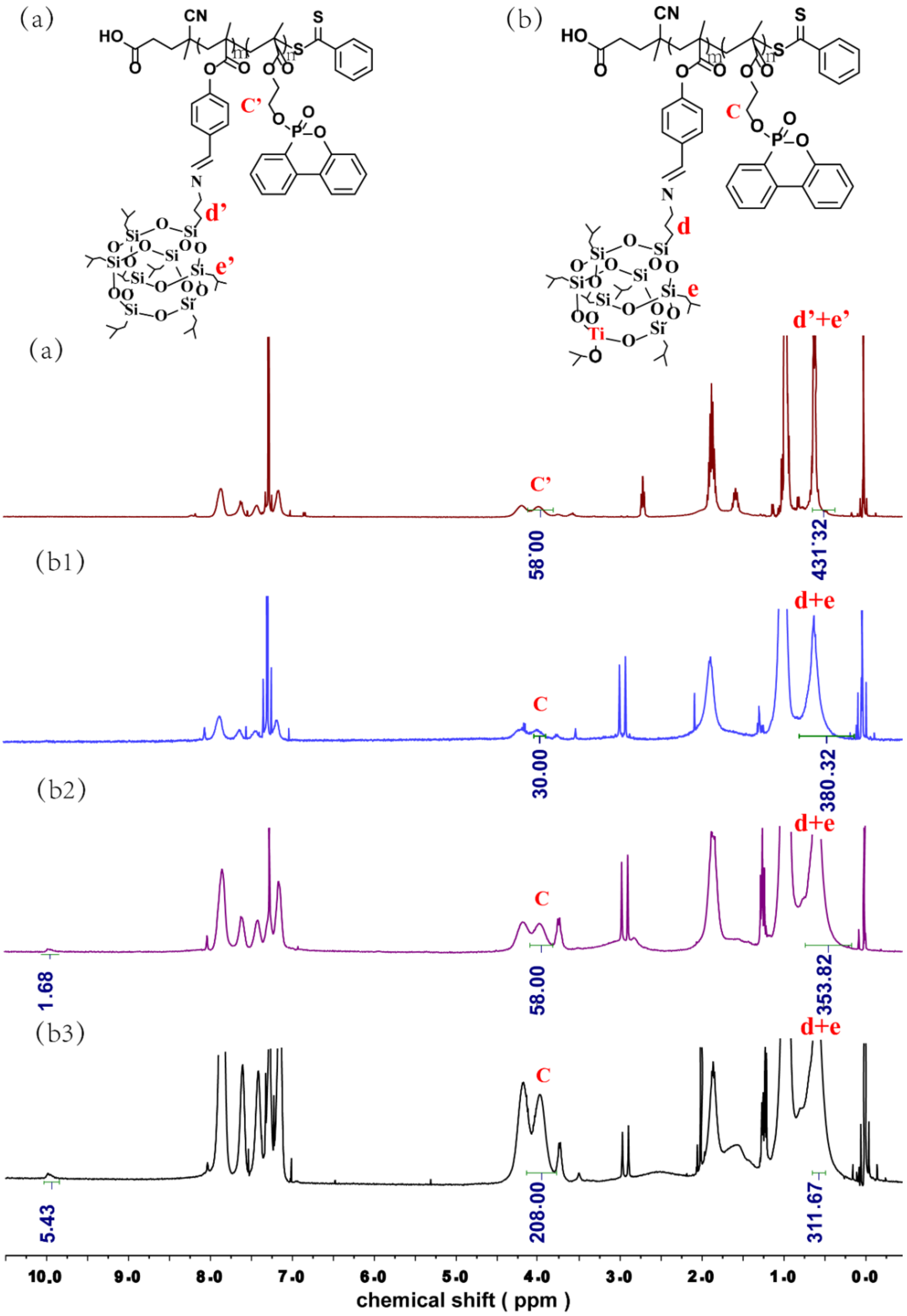

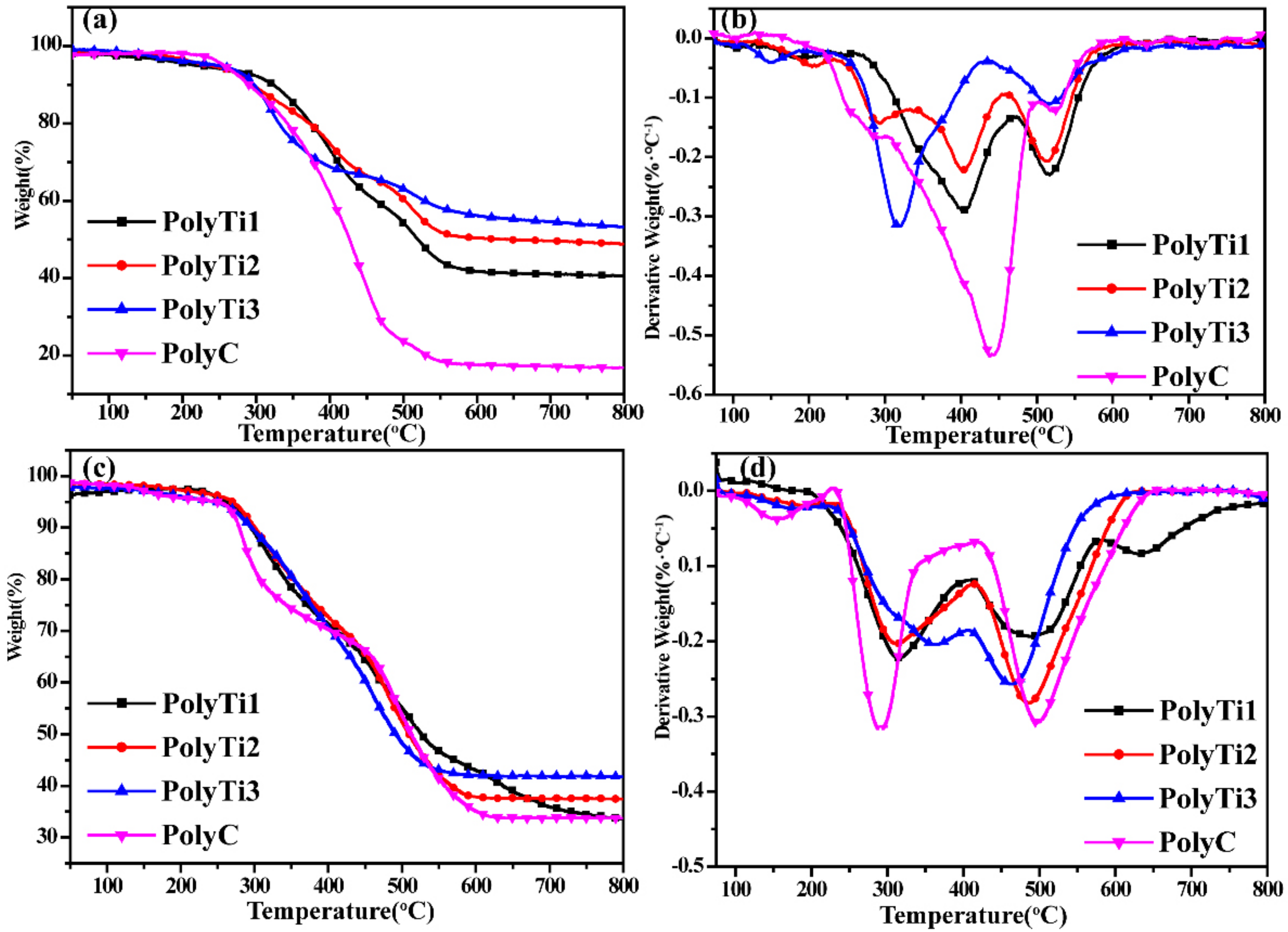
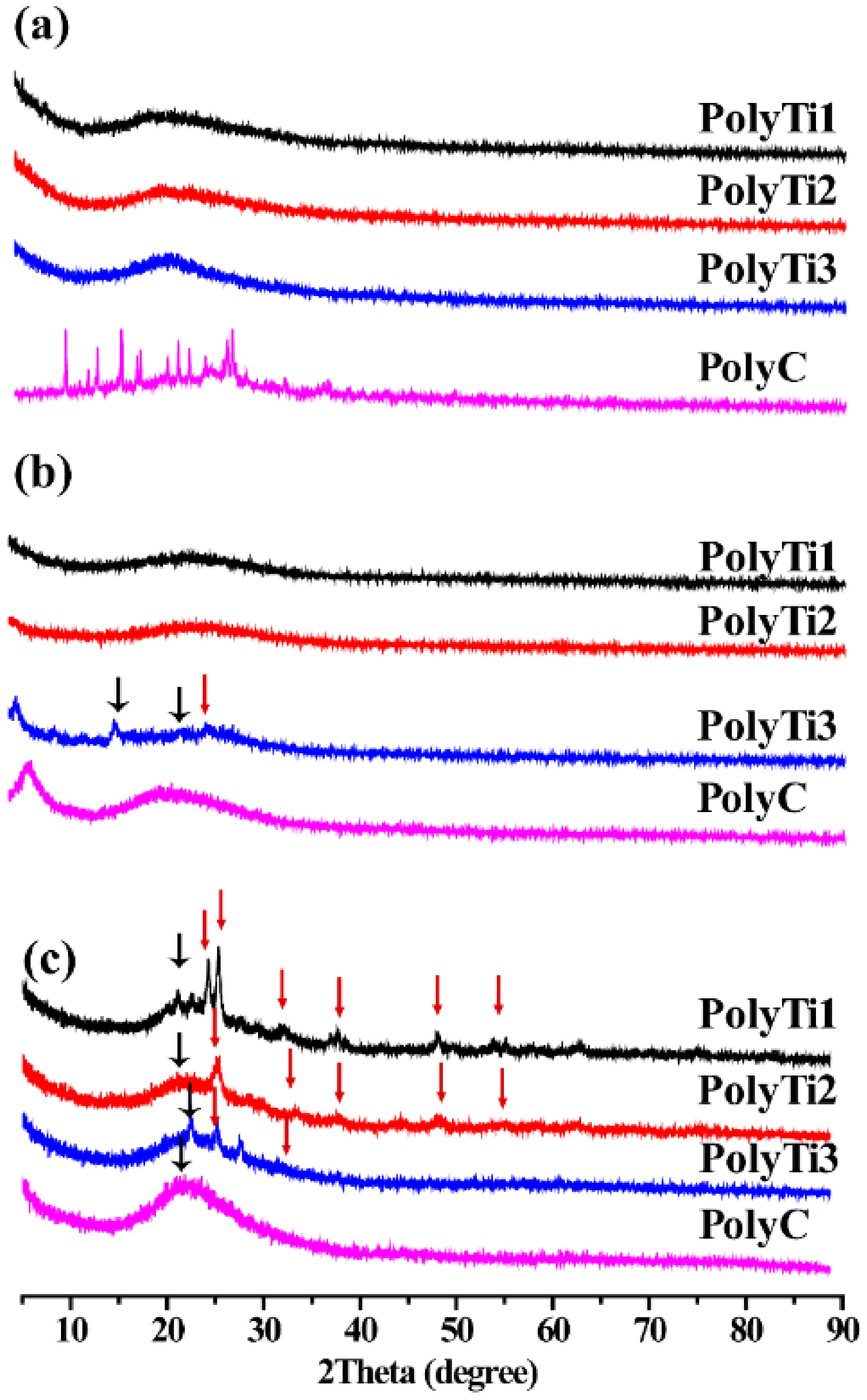



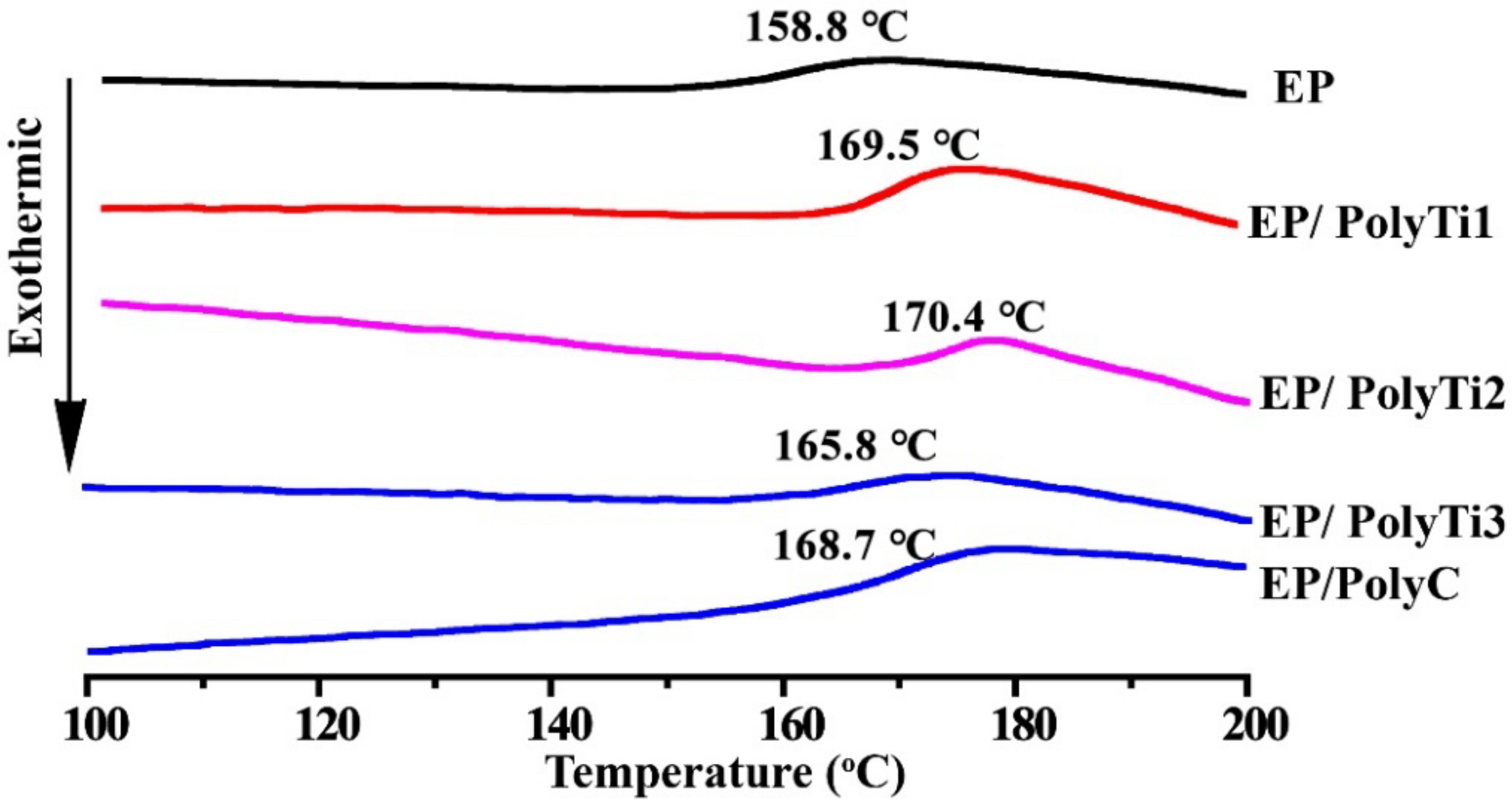
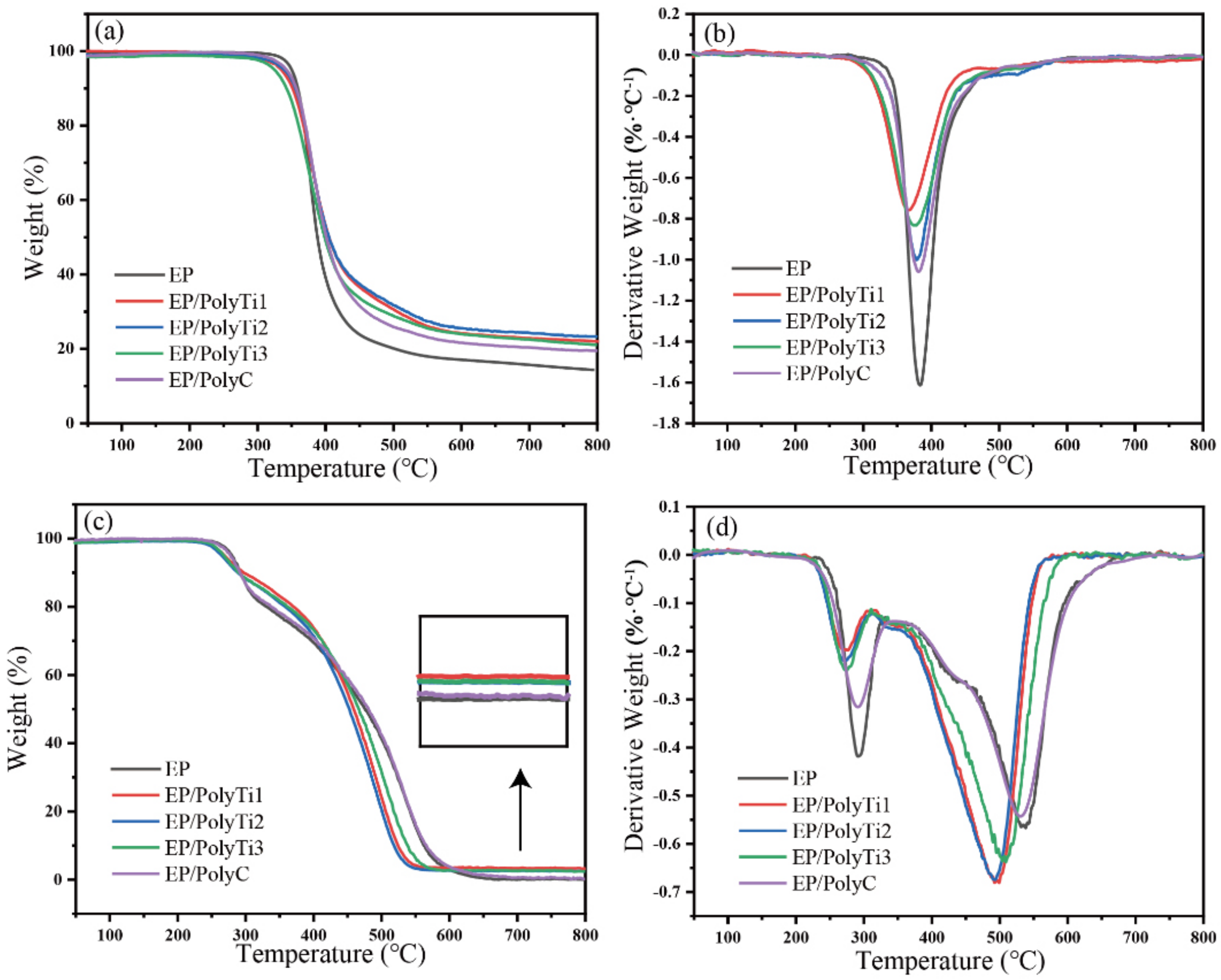



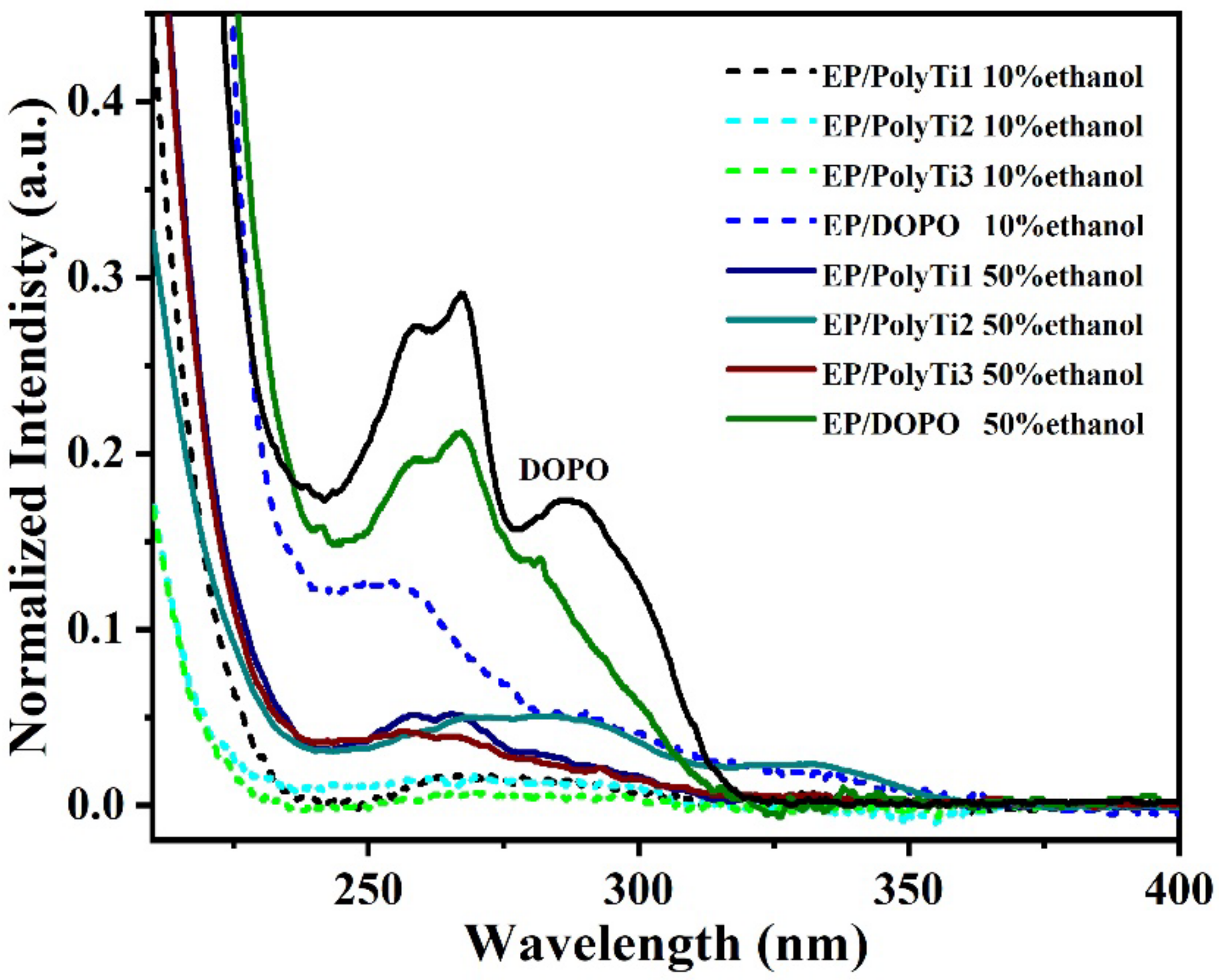
| Samples | DGEBA+DDM (wt%) | Poly[(Ti-POSS-HAMA)m-b-HEPOMAn] | Element Content (%) | ||
|---|---|---|---|---|---|
| P | Si | Ti | |||
| EP | 100 | 0 | 0 | 0 | 0 |
| EP/PolyC | 95 | 5 | 0.21 | 0.77 | 0 |
| EP/PolyTi1 | 95 | 5 | 0.12 | 0.77 | 0.20 |
| EP/PolyTi2 | 95 | 5 | 0.22 | 0.68 | 0.17 |
| EP/PolyTi3 | 95 | 5 | 0.50 | 0.40 | 0.10 |
| Sample | Integration Area | The Molar Ratio of HAMA: HEPOMA m/n = 2Aa/A9 | Chemical Formula of Poly(HAMAm-b-HEPOMAn) | |
|---|---|---|---|---|
| Peak Ha -CHO/ δ 9.98 | Peak H9 -CH2-O-/ δ 4.28 | |||
| Poly1 | 1.00 | 1.14 | 1:0.57 | poly(HAMA28-b-HEPOMA16) |
| Poly2 | 1.00 | 2.16 | 1:1.08 | poly(HAMA28-b-HEPOMA30) |
| Poly3 | 1.00 | 7.75 | 1:3.9 | poly(HAMA28-b-HEPOMA109) |
| Samples | LOI (%) | UL-94 | |||
|---|---|---|---|---|---|
| Burning Grade | T1 (s) | T2 (s) | Dripping | ||
| EP | 23.0 | NR | >30 | / | Yes |
| EP/PolyTi1 | 27.1 | V-0 | 1 | 5 | No |
| EP/PolyTi2 | 28.8 | V-0 | 1 | 7 | No |
| EP/PolyTi3 | 28.2 | V-0 | 1 | 5 | No |
| EP/PolyC | 28.1 | V-0 | 7 | 5 | No |
| Samples | Nitrogen | Air | |||||
|---|---|---|---|---|---|---|---|
| Td/°C | Tmax/°C | Char/wt% | Td/°C | Tmax1/°C | Tmax2/°C | Char/wt% | |
| EP | 349.9 | 383.2 | 14.3 | 279.4 | 291.1 | 537.5 | 0.02 |
| EP/PolyTi1 | 334.3 | 367.4 | 22.0 | 268.3 | 270.2 | 496.3 | 3.24 |
| EP/PolyTi2 | 338.2 | 380.5 | 23.3 | 264.8 | 272.0 | 492.2 | 2.40 |
| EP/PolyTi3 | 324.6 | 376.0 | 21.1 | 263.0 | 273.0 | 506.6 | 2.44 |
| EP/PolyC | 342.3 | 380.5 | 19.5 | 277.5 | 289.9 | 523.6 | 0.19 |
| Sample | δmax (MPa) | Fracture Energy (N/m) |
|---|---|---|
| EP | 178.32 | 394.33 |
| EP/PolyTi1 | 249.85 | 987.47 |
| EP/PolyTi2 | 209.37 | 699.54 |
| EP/PolyTi3 | 208.35 | 510.39 |
| EP/PolyC | 200.14 | 540.29 |
| Sample | LOI | Increase Rate (%) | UL-94 | DSC Tg | Increase Rate (%) | Char (wt% in Air) | Bending Strength (MPa) | Increase Rate (%) | Resource |
|---|---|---|---|---|---|---|---|---|---|
| EP/5%PolyTi2 | 28.8 | 25.0 | V-0 | 170.4 | 7.3 | 2.4 | 100.7 | 18.4 | This work |
| EP/5%Ti-POSS+5%DOPO | 32.7 | 29.8 | V-0 | 158.5 | 0.6 | 1.3 | 90.51 | 27.1 | [23] |
| EP/6%Ti-POSS-bisDOPO | 39.2 | 56.8 | V-0 | 163.8 | 7.7 | 2.1 | 86.12 | 11.1 | [22] |
| EP/5%POSS-bisDOPO+5%Titanate | 31.0 | 18.3 | V-0 | 161.3 | 4.0 | 1.3 | _ | _ | [36] |
Publisher’s Note: MDPI stays neutral with regard to jurisdictional claims in published maps and institutional affiliations. |
© 2022 by the authors. Licensee MDPI, Basel, Switzerland. This article is an open access article distributed under the terms and conditions of the Creative Commons Attribution (CC BY) license (https://creativecommons.org/licenses/by/4.0/).
Share and Cite
Zhou, R.; Lin, L.; Zeng, B.; Yi, X.; Huang, C.; Du, K.; Liu, X.; Xu, Y.; Yuan, C.; Dai, L. Diblock Copolymers Containing Titanium-Hybridized Polyhedral Oligomeric Silsesquioxane Used as a Macromolecular Flame Retardant for Epoxy Resin. Polymers 2022, 14, 1708. https://doi.org/10.3390/polym14091708
Zhou R, Lin L, Zeng B, Yi X, Huang C, Du K, Liu X, Xu Y, Yuan C, Dai L. Diblock Copolymers Containing Titanium-Hybridized Polyhedral Oligomeric Silsesquioxane Used as a Macromolecular Flame Retardant for Epoxy Resin. Polymers. 2022; 14(9):1708. https://doi.org/10.3390/polym14091708
Chicago/Turabian StyleZhou, Ruirui, Lijie Lin, Birong Zeng, Xindan Yi, Chenyu Huang, Kunpeng Du, Xiaohui Liu, Yiting Xu, Conghui Yuan, and Lizong Dai. 2022. "Diblock Copolymers Containing Titanium-Hybridized Polyhedral Oligomeric Silsesquioxane Used as a Macromolecular Flame Retardant for Epoxy Resin" Polymers 14, no. 9: 1708. https://doi.org/10.3390/polym14091708






